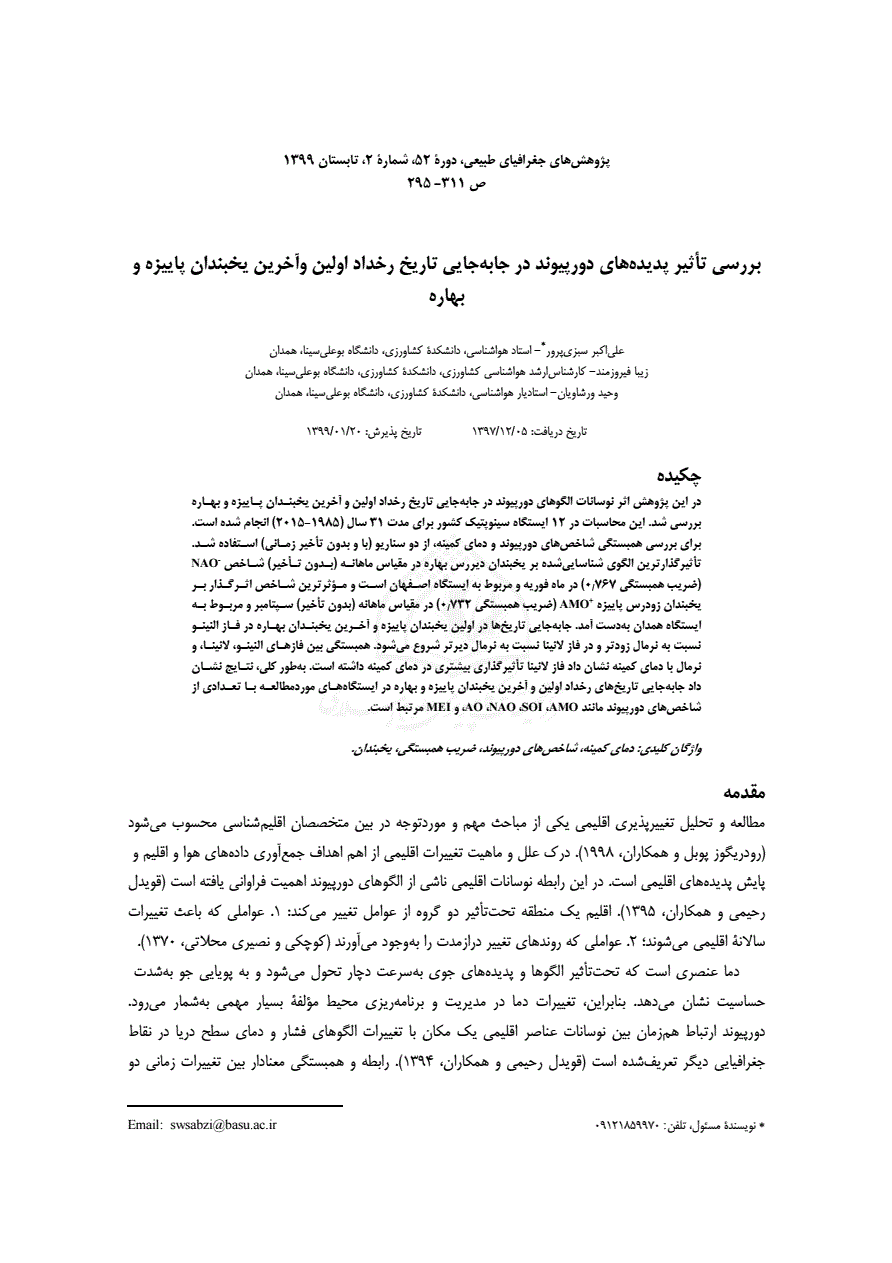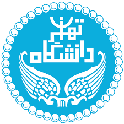چکیده:
در این پژوهش اثر نوسانات الگوهای دورپیوند در جابهجایی تاریخ رخداد اولین و آخرین یخبندان پاییزه و بهاره بررسی شد. این محاسبات در 12 ایستگاه سینوپتیک کشور برای مدت 31 سال (۱۹۸۵-2015) انجام شده است. برای بررسی همبستگی شاخصهای دورپیوند و دمای کمینه، از دو سناریو (با و بدون تأخیر زمانی) استفاده شد. تأثیرگذارترین الگوی شناساییشده بر یخبندان دیررس بهاره در مقیاس ماهانه (بدون تأخیر) شاخص NAO- (ضریب همبستگی 767/0) در ماه فوریه و مربوط به ایستگاه اصفهان است و مؤثرترین شاخص اثرگذار بر یخبندان زودرس پاییزه AMO+ (ضریب همبستگی 732/0) در مقیاس ماهانه (بدون تأخیر) سپتامبر و مربوط به ایستگاه همدان بهدست آمد. جابهجایی تاریخها در اولین یخبندان پاییزه و آخرین یخبندان بهاره در فاز النینو نسبت به نرمال زودتر و در فاز لانینا نسبت به نرمال دیرتر شروع میشود. همبستگی بین فازهای النینو، لانینا، و نرمال با دمای کمینه نشان داد فاز لانینا تأثیرگذاری بیشتری در دمای کمینه داشته است. بهطور کلی، نتایج نشان داد جابهجایی تاریخهای رخداد اولین و آخرین یخبندان پاییزه و بهاره در ایستگاههای موردمطالعه با تعدادی از شاخصهای دورپیوند مانند AMO، SOI، NAO، AO، و MEI مرتبط است.
Introduction Frost and freezing are important and risk generating factor in the agricultural sector of the country. Frost is a phenomenon that at low temperatures which could damage or destruct the plant organs. Various studies by researchers show that last spring frost (LSF) and first autumn frost (FAF) along with gradual global warming have significant impacts on agriculture and natural resources. Teleconnection patterns represent large changes which can periodically alter other atmospheric patterns such as temperature, wind, humidity and precipitation in regional and global scales. The purpose of this study was to investigate the effect of different teleconnection indices on variability of FAF and LSF events during the last 31 years at 12 Synoptic stations of Iran. Materials and Methods To detect the relationships between frost events and teleconnection patterns we used two different data sources. As the first source, the screen daily minimum air temperature (Tmin) were used as the frost indicator. We also applied 10 different teleconnection indices in daily and monthly scales. Daily minimum air temperature were obtained from the Iran Meteorological Organization (IRIMO) for the historical period of 1985-2015. The teleconnection indices were also utilized for the same period (http://www.cdo.noaa.gov). After the data quality control, the outlier data were removed from the analysis. Normality of data was evaluated by Kolmogorov-Smirnov test. For time series with normal distribution (P Results and Discussion In case of lag-free correlations in the monthly time scale the strongest correlation between teleconnection indices and minimum temperature was observed for NAO- (-0.76), in February for Isfehan Station, which can cause a delay in occurrence of last spring frost. By applying the time lag to the correlation, the strongest correlation was found for AMO+ with time lag of 11 month. In seasonal time scale, the strongest lag-free correlations were found for AO-during the last spring frost (LSF). By applying time lag-correlation, the strongest correlation was evident between Tmin temperature and AMO+, indicating that this index was the most influencing teleconnections (with 3 seasons lag). In comparison with the normal phase, the occurrence of El Nino causes earlier autumn and spring frost events. In contrast, La Nina event will postpone the dates of autumn and spring frosts. This means that if La Nina occurs in winter, the strongest effect will be appeared in the autumn of the following year. The correlation between the El Nino, La Nina and Normal phases with minimum temperature showed that the La Nina phase has the highest effect on shifting the dates of the minimum temperature event. The strongest correlation between the minimum temperature of autumn and teleconnection patterns (correlation coefficient of 0.382) was observed for AO- , highlighting the fact that the occurrence of the Negative phase of this phenomenon leads to the cause a delay in occurrence of first autumn frost (FAF). For the last spring frost (LSF), the strongest correlation was found for SOI- index (correlation coefficient of 0.665) for Hamedan station, leading to early spring cold in the region. The correlation between the phases of the El Nino, La Nina and Normal with minimum temperatures showed that the La Nina phase has the most effective phase affecting the minimum temperature. The results of this research can be used for wise managing of risk factors and arranging appropriate time of planting agricultural products, as well as insurance for agricultural products. Conclusions This study highlighted the impact of teleconnection phenomena on shifting the dates of autumn and spring frost. It was shown, that the occurrence of teleconnection can significantly shift the date of first and last frost in the study region. For some teleconnections cause the advance, but for others may postpone (up to 50 days) the frost event. We found different results for lag-free correlations compared to lag-correlations. For instance, for monthly analysis of lag-free correlations, the strongest correlation between teleconnection indices and minimum temperature was found for NAO- (-0.76), but for lag correlations, the strongest correlation was found for AMO+. In comparison with the normal phase, the occurrence of El Nino causes earlier autumn and spring frost events. The results showed that Shifting the Date of First )Autumn( and Last )Spring( Frost Events at the stations were related to a number of teleconnection patterns such as AMO, SOI, NAO, AO and MEI. In contrast, La Nina event will postpone the dates of autumn and spring frosts. Further works are required to better understanding of the impacts of teleconnection events on other meteorological parameters such as humidity which was not investigated in this research. Introduction Frost and freezing are important and risk generating factor in the agricultural sector of the country. Frost is a phenomenon that at low temperatures which could damage or destruct the plant organs. Various studies by researchers show that last spring frost (LSF) and first autumn frost (FAF) along with gradual global warming have significant impacts on agriculture and natural resources. Teleconnection patterns represent large changes which can periodically alter other atmospheric patterns such as temperature, wind, humidity and precipitation in regional and global scales. The purpose of this study was to investigate the effect of different teleconnection indices on variability of FAF and LSF events during the last 31 years at 12 Synoptic stations of Iran. Materials and Methods To detect the relationships between frost events and teleconnection patterns we used two different data sources. As the first source, the screen daily minimum air temperature (Tmin) were used as the frost indicator. We also applied 10 different teleconnection indices in daily and monthly scales. Daily minimum air temperature were obtained from the Iran Meteorological Organization (IRIMO) for the historical period of 1985-2015. The teleconnection indices were also utilized for the same period (http://www.cdo.noaa.gov). After the data quality control, the outlier data were removed from the analysis. Normality of data was evaluated by Kolmogorov-Smirnov test. For time series with normal distribution (P <0.05), the Pearson’s significance test was performed. For other time series, when the normal distribution was not the case, Spearman's non-parametric test was applied.
خلاصه ماشینی:
خورشيددوست و همکاران (٩٣٨١)، با استفاده از شاخص چندمتغيرة انسو، نقش اين پديده را در تغييرپذيري بارشهاي فصلي استان آذربايجان شرقي مطالعه کردند؛ نتايج آنها نشان داد که فقط در فصل پاييز همبستگي مثبت و معنيداري بين اين شاخص و بارش مشاهده شده است که به معناي افزايش ميزان بارشهاي پاييزي به هنگام وقوع النينو و برعکس کاهش بارش در فاز لنينا است.
قويترينضرايبهمبستگي شاخصهايدورپيوندبادمايکمينهبهصورت همزمان درمقياس ماهانه)٩١١٢-٥٠٩٢) همانطورکه در شکل ٣ مشاهده ميشود، هفت ايستگاهي که با شاخص AMO همبستگي مثبت و معناداري را نشان داده اند مؤيد اين مطلب اند که در فاز مثبت اين شاخص دما بالتر از حد نرمال خواهد شد که ميتواند سبب به تأخير + افتادن يخبندان زودرس پاييزه شود که با نتايج مطالعة قنقرمه و همکاران (٦٤٩١) در رابطه با افزايش دما در AMO همخواني دارد.
هرگاه دو مرکز کمفشار ايسلند و پرفشار آزورز از شدت بيشتري برخوردار باشند، شاخص نوسانات اطلس شمالي مثبت خواهد بود و هرگاه دو مرکز فشاري مذکور از شدت کمتري برخوردار باشند، نتيجة حاصله منفي ميشود (مرادي، ٩٣٨٣) همبستگي منفي بين NAO و دماي هوا در ايران وجود دارد (قنقرمه و همکاران، ٦٤٩١؛ سبحاني و همکاران، ٩٣١٣؛ ياراحمدي و عزيزي، ٩٣٨٢).
در اين پژوهش از دادههاي حداقل دماي هوا براي دوازده ايستگاه در ايران جهت تعيين روند جابهجايي تاريخ رخداد اولين و آخرين يخبندان هاي پاييزه و بهاره در مقياس ماهانه و فصلي و بررسي ارتباط اين تغييرپذيري ها با الگوهاي دورپيوند در طي سالهاي ٩١٨١-٦٤٩١ استفاده شد.

(پژوهیار,
,
,
)

